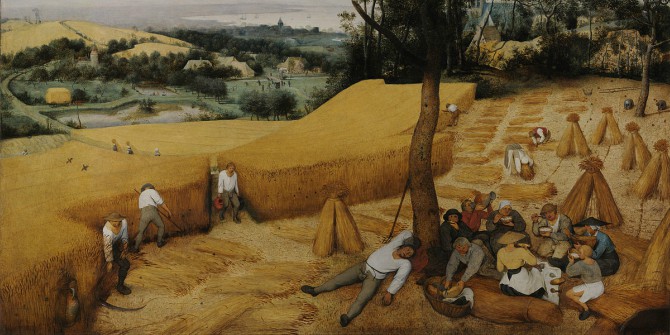
Anybody relying for their information on the current headlines would find it hard to make sense of what is happening in the labour market. On the one hand, the news media are awash with apocalyptic forecasts, often backed up by studies from reputable organisations such as the US National Bureau of Economic Research , the Oxford Martin School or the Bruegel think tank, that robots, machine learning, drones, d3D printers, driverless cars and other applications of Artificial Intelligence are going to eliminate very large numbers of jobs, not just in manufacturing but also in service industries, ranging from low-skill tasks like picking and packing in warehouses and home delivery right up to high-skill professional tasks like legal research or stockbroking.
On the other hand, employment levels in the UK are at an all-time high of 74.6 per cent, with the unemployment level, which averaged over 7 per cent from 1971 to 2016, having fallen to just 4.7 per cent in January, 2017.
So, are we facing mass unemployment or not? Here we are, nearly a decade after a major financial crisis that led to job losses, austerity and waves of corporate restructuring including bankruptcies, mergers and acquisitions, seeing the emergence of new winners, with new business models and the birth of new industries, with new technological applications playing a key role. If we take a broad historical view, this is actually quite a familiar story.
We could look, for example, at the development of new industries based on the spread of electrical power and mass entertainment after the 1929 crash, or of computerisation after the 1973 energy crisis, or the explosive growth of the Internet in the decade after the infamous 1987 Black Monday. Each of these technologies was also, of course, instrumental in displacing large numbers of jobs in older industries. And with each wave, livelihoods were irrevocably damaged, because the new jobs were not created in the same areas, or for the same people, as the old ones.
The elderly look on in amazement at the desirable new labour-saving appliances their grandchildren buy, remembering the back-breaking drudgery of the old methods. But for every gleaming new factory in one part of the world, there are piles of rusting machinery in others, along with devastated lives and communities. Such ‘creative destruction’, as Schumpeter called it, is, surely, part and parcel of capitalism as usual.
So why, in the second decade of the 21st century, are so many commentators, on so many different parts of the political spectrum, convinced that this time things will be different: that we are, in Paul Mason’s phrase, moving into a period that could be described as ‘postcapitalist’?
Part of the explanation might lie in the way that capitalism is often seen, especially by the young, as a single, monolithic system that embraces all aspects of life. Perhaps a more useful way of understanding it is a somewhat messy assemblage of different capitalists competing with each other, scrabbling for market share, experimenting with new business models and often failing. In times of crisis, when many are going to the wall, technologies (including some that have been around for a while) may be seized on, not as part of an orchestrated general plan, but in much more piecemeal ways, by particular firms looking for means to restore profitability: to reduce labour costs, develop new products or services or enter new markets.
Obvious first targets for automation are processes where labour costs are high, usually because they require scarce skills or workers are well organised. So it is not surprising that skilled print workers were first in the firing line for digitisation, or auto factories for robots. The first companies to introduce innovations can make a killing – getting ahead of their competitors with a step change in increased productivity.
But such advantages do not last long. Once the technology is generally available, it is open to any competitor to buy it at the lowest market price and copy these production methods. A race to the bottom is started, which can only be sidestepped by firms that continue to innovate. It is fanciful to imagine that it would be possible to populate the world’s factories with 2017 state-of-the-art robots and then just leave them to get on with production. Leaving aside the question of how these robots are to be assembled and maintained, there is no conceivable business model that would make this profitable over any sustained period of time.
A much more likely scenario is that vast new industries will grow up to manufacture these new means of production which, like today’s laptops and mobile phones, will rapidly become obsolete and need replacing. These industries will also give birth to new service jobs, involved in their design, distribution, maintenance and in dealing with the unintended consequences of their widespread adoption (such as cyber-crime and new safety hazards).
Current technologies do not just create new kinds of jobs, they also change the way work is organised, managed and controlled. My research has shown that 2.5 per cent of workers already get more than half their income from online platforms. These new organisational models do not just change the way existing jobs are managed but also bring new areas of economic activity within the direct orbit of capitalism, for instance by drawing into the formal economy the kinds of cash-in-hand work done by window-cleaners, dog-walkers, baby-sitters or gardeners. They may not be jobs in the traditional sense, but they are work, with the potential to be organised differently in the future, that can form the basis of profitable new industries.
Another factor that blinkers thinking about the future of work is a failure to see beyond the boundaries of the existing industrial structure and imagine where other new industries will emerge from. Whether it’s the DNA of plants, the human needs for entertainment, sociality and health or outer space, the universe is full of new opportunities for commodification. The question is, can the planet sustain them?
♣♣♣
Notes:
- This blog post is based on the author’s paper Logged labour: a new paradigm of work organisation?, in Work Organisation, Labour & Globalisation, Vol. 10, No. 1 (Spring 2016), pp. 7-26
- The post gives the views of its author, not the position of LSE Business Review or the London School of Economics.
- Featured image credit: The Harversters, by Pieter Brueghel the Elder (1526/1530–1569) – PAH1oMZ5dGBkxg at Google Cultural Institute, zoom level maximum, Public Domain,
- Before commenting, please read our Comment Policy.
 Ursula Huws is Professor of Labour and Globalisation at the University of Hertfordshire’s Business School, where she has recently directed the COST Action IS1202 on the Dynamics of Virtual Work along with other research on creative labour. She is the editor of the book series Dynamics of Virtual Work, and of the Work Organisation, Labour and Globalisation Journal. Her most recent book is Labor in the Global Digital Economy: the Cybertariat Comes of Age. She has developed and managed large international research projects, not only in Europe but also in the Americas, Asia and Australia. In addition to academic research and evaluation, Professor Huws has authored many research reports for international and national government bodies, and also written and edited books and articles aimed at more popular audiences. Her work has appeared in translation in a number of languages including Chinese, Swedish, German, French, Italian, Greek, Hungarian, Danish, Portuguese, Turkish, Spanish, Norwegian, Hindi, Japanese, Korean and Serbo-Croat.
Ursula Huws is Professor of Labour and Globalisation at the University of Hertfordshire’s Business School, where she has recently directed the COST Action IS1202 on the Dynamics of Virtual Work along with other research on creative labour. She is the editor of the book series Dynamics of Virtual Work, and of the Work Organisation, Labour and Globalisation Journal. Her most recent book is Labor in the Global Digital Economy: the Cybertariat Comes of Age. She has developed and managed large international research projects, not only in Europe but also in the Americas, Asia and Australia. In addition to academic research and evaluation, Professor Huws has authored many research reports for international and national government bodies, and also written and edited books and articles aimed at more popular audiences. Her work has appeared in translation in a number of languages including Chinese, Swedish, German, French, Italian, Greek, Hungarian, Danish, Portuguese, Turkish, Spanish, Norwegian, Hindi, Japanese, Korean and Serbo-Croat.






This piece seems to miss the two biggest trends that affect the future of work :
1) Rise in insecurity/precarity due to accelerating rate of change
As a young manger in a Unilever factory of the 1990s I well remember giving out 50 year service awards to loyal employees who had done essentially the same job, in the same soap factory, from the age of 16 through till retirement. Such continuity will be unthinkable in the new era, when the half-life of any given job will continue to drop to many times less than the length of a working life. This creates huge insecurity for workers who face gaps in their employment and the challenge of constantly retraining and being forced to compete both with younger, better educated job seekers, and more flexible immigrant workers, as they grow older. It is critical to comprehend the damaging effects of this on individual lives, and understand that this change is not revealed by overall unemployment statistics. Yes there will be job creation as well as destruction, and workers will adapt because they have to, in order to take whatever work they can find. Politicians and economists may take comfort in the fact that overall unemployment is not rising, but they have completely failed to understand the job insecurity that these top level numbers can hide.
2) The downward spiral of real incomes is creating rising inequality
In reacting to this new employment reality many displaced workers will find themselves trading down as the only way to get jobs in an increasingly competitive market. So a displaced auto-worker who used to be in a high productivity, highly paid assembly line job may end up working in a low productivity, low paid role as an assistant manager in retail work, as a self-employed delivery driver, or as a hospital porter. This of course explains why productivity growth has stalled nationally. Labour productivity is still rising in big, increasingly automated companies, and this in turn drives up salaries for the increasingly small pool of high-tech workers they depend upon. But if displaced workers trade down into lower productivity roles with lower pay, then productivity as a national average stalls, and rising income inequality continues to accelerate.
Politicians and economists must learn to delve into the detail of the divisions which are relentlessly opening up in our society. Simply taking comfort based on average unemployment numbers, and national GDP growth will hide huge and growing social dislocations. The political disruptions of Brexit and Trump could yet turn out to be minor tremors compared to the earthquakes to come if we fail to understand what is happening to the future of work for the majority of voters.